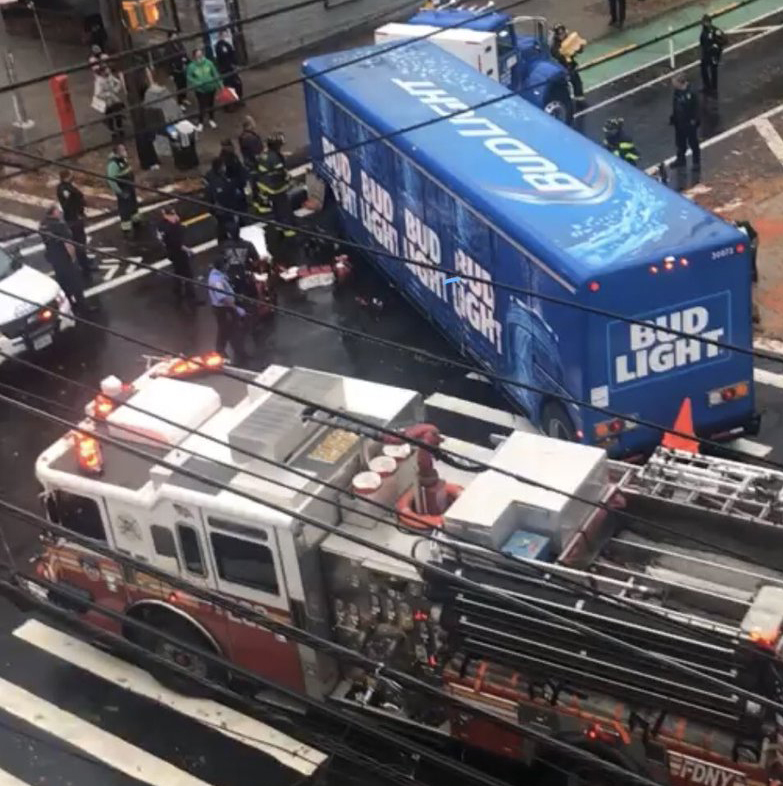Opinion: The City’s Bike Lanes Need More Protection Than Flimsy Flex Posts
The death of a delivery worker in Astoria last year shows the deficiencies of the DOT's approach.


The two-way Crescent Street bike lane in Astoria has been a game-changer — creating the spine of a bike network through the center of Astoria, demonstrating high demand for safe biking infrastructure, and making the street safer for all users.
Yet the Crescent Street bike lane, for all its successes, has some real flaws. Moreover, the stubborn, negligent refusal of those in charge to admit the flaws and fix them exposes the deficiencies of the city’s approach to protected bike lanes.
One year ago this month, a 35-year old father, husband, delivery worker, immigrant and Queens resident, Alfredo Cabrera Linconia, was killed on the job when the driver of a semi-truck with an (illegal) 53-foot trailer made an (illegal) right turn at the intersection of Astoria Boulevard and Crescent Street and ran him over, killing him. Cabrera Linconia, who was riding a moped, was not in the Crescent Street bike lane, but the lane’s design likely helped cause his death: By removing parking on both sides of the Crescent and installing only some widely spaced, flimsy flex posts to buffer the bike lane, the Department of Transportation purposefully created a wider street, which permitted the oversize truck/trailer driver to make the turn onto Crescent from Astoria Boulevard into the bike lane.
https://twitter.com/macartney/status/1326971736055754755
For weeks before Cabrera Linconia’s death, local activists had sounded the alarm that several blocks of the new Crescent bike lane weren’t actually protected and were too porous to cars and trucks. We saw daily evidence that drivers ignored the flimsy flex posts and treated the new bike lane as their space — behavior allowed if not encouraged by the DOT’s deficient design and materials.
https://twitter.com/macartney/status/1327278947692924929
We even organized our elected officials to write to the DOT in order to demand that it finish the job and make the bike lane fully protected by installing hardier barriers. But then-DOT Commissioner Polly Trottenberg denied the requested safety upgrades, writing that she and the agency were satisfied with the design “as-is” and would take a wait-and-see approach.
Tragically, we didn’t have to “wait-and-see” very long: Less than a week after she sent her letter, Cabrera Linconia would be killed on one of the exact blocks where we had requested safety upgrades but which she had advised were “not feasible.”
The driver 37313MM blocked the bike lane near 39-21 Crescent St on November 15. This is in Queens Community Board 01 #cb1queens & #NYPD114. #VisionZero #BlockedBikeNYC pic.twitter.com/jNdLiwexo0
— Reported (@Reported_NYC) November 15, 2021
A few years ago, when I asked Mayor de Blasio at a town hall meeting why folks had to die before streets received safety upgrades, he snapped: “I couldn’t disagree more that an administration that has… done Vision Zero is just waiting around for someone to die. I resent that, I think that’s unfair.”
But, in fact, it wasn’t until after Cabrera Linconia died that the DOT decided to give the Crescent bike lane a minor safety upgrade in the exact spot where he was mowed down, by replacing some of the widely spaced flex posts with heavier duty and more tightly placed Qwick Curbs. (Even this was insufficient; the department didn’t install the posts all the way to the crosswalk, which still encourages dangerous, wide turns from trucks and other large vehicles.)

It makes me wonder: If the DOT’s engineers think that paint and flimsy flex posts do not provide enough safety for the Crescent bike lane at the spot where Cabrera Linconia died, why do they posit that they are safe at other blocks?
These flex delineators “protecting” the bike lane from the cars can easily be run over by cars.
If cars & trucks can drive in a protected bike lane then it’s not a truly protected bike lane pic.twitter.com/EIIxPkVmO1
— Zohran Kwame Mamdani (@ZohranKMamdani) April 29, 2021
Why weren’t all remaining ineffective flex posts on Crescent (from Hoyt Avenue South to Newtown Avenue and from 38th Avenue to 40th Avenue) replaced with more robust posts? Heck, why weren’t the same “paint and post” treatments in bike lanes around the entire city replaced with more worthy bollards?
Again, why does it appear that people must die for the DOT to consider these clearly necessary changes “feasible”? A year after Cabrera Linconia’s death, Trottenberg is gone (having been well rewarded with a promotion to the U.S.DOT) but the city remains stuck with inadequate protection on Crescent on the exact blocks where it’s needed most.
Soon we’ll have a new mayor (who didn’t sign our Assembly member’s pledge to improve Crescent) and a new DOT commissioner but, most likely, the DOT’s policy will still feature only small measures for raising mode share and safety for bikers and walkers. Ultimately, the car (and its need for endless “level of service” and parking) will remain king of the road.
But that doesn’t have to be the case: The Crescent Street bike lane offers us a road map. We know how to fix it, how to make it even better, and how to replicate its successes in other neighborhoods. We know how to protect riders like Cabrera Linconia. It’s up to us.
rest in peace, Alfredo.
we will never forget you. pic.twitter.com/uqAK75ZNiY
— Zohran Kwame Mamdani (@ZohranKMamdani) November 14, 2020
Macartney Morris (@macartney) is an Astoria-based transit and safe-streets activist and organizer. A version of this post was originally published at his blog, macartney.nyc.






